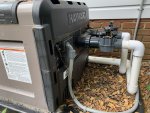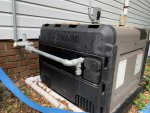- Nov 10, 2016
- 31
- Pool Size
- 28000
- Surface
- Vinyl
- Chlorine
- Salt Water Generator
- SWG Type
- Pentair Intellichlor IC-40
[Edit] sorry, I didn't realize heaters were classified as "everything else" so I am now posting this to the correct forum. Hopefully I can go back and delete my original post in the equipment/plumbing forum or a moderator can do that if I can't.
I'm not sure if I put my pool details in my profile so here goes: 27K gallon, vinyl liner, IC40 chlorinator, DE filter, variable speed Pentair pump.
I'm shopping for a basic 250K BTU natural gas pool heater and for the same price I can get either the:
Hayward H250FDN - comes with cupro-nickel heat exchanger
or
Pentair MasterTemp 460732 - Pool repair company doing other work this summer recommends it for durability and serviceability
What is your take on which one ultimately lasts the longest? I will have a check valve between the CG and heater but the salt water at 3000 PPM worries me. I like the idea of a cupro-nickel HE, though in real world practice I don't know if it makes enough difference to worry about it. I'd just take the pool company's recommendation if it wasn't for this issue. The CU version of the Pentair is more expensive so I want to avoid that if possible.
I don't expect more than about 8 years out of the heater and we can reassess if a heater is necessary when it fails next time. It will probably be time for a liner then anyway and a series of other deck related repairs so I'm OK with an 8 year life expectancy such that an ASME rated or otherwise more expensive heater is not worth the money at this time.
I'd like feedback on this, then I'll have a couple questions about piping and electrical service to the heater depending on which model I choose. I've looked at both installation manuals and still don't understand the configurations they are proposing.
I'm not sure if I put my pool details in my profile so here goes: 27K gallon, vinyl liner, IC40 chlorinator, DE filter, variable speed Pentair pump.
I'm shopping for a basic 250K BTU natural gas pool heater and for the same price I can get either the:
Hayward H250FDN - comes with cupro-nickel heat exchanger
or
Pentair MasterTemp 460732 - Pool repair company doing other work this summer recommends it for durability and serviceability
What is your take on which one ultimately lasts the longest? I will have a check valve between the CG and heater but the salt water at 3000 PPM worries me. I like the idea of a cupro-nickel HE, though in real world practice I don't know if it makes enough difference to worry about it. I'd just take the pool company's recommendation if it wasn't for this issue. The CU version of the Pentair is more expensive so I want to avoid that if possible.
I don't expect more than about 8 years out of the heater and we can reassess if a heater is necessary when it fails next time. It will probably be time for a liner then anyway and a series of other deck related repairs so I'm OK with an 8 year life expectancy such that an ASME rated or otherwise more expensive heater is not worth the money at this time.
I'd like feedback on this, then I'll have a couple questions about piping and electrical service to the heater depending on which model I choose. I've looked at both installation manuals and still don't understand the configurations they are proposing.




